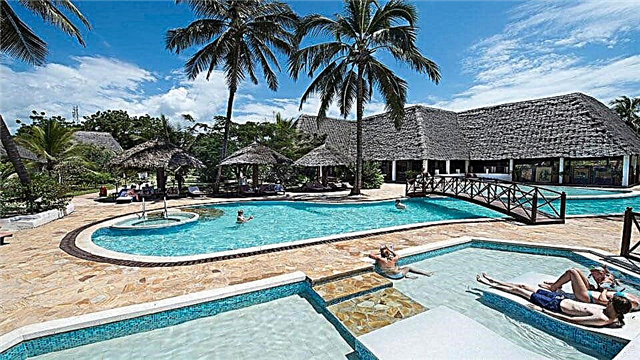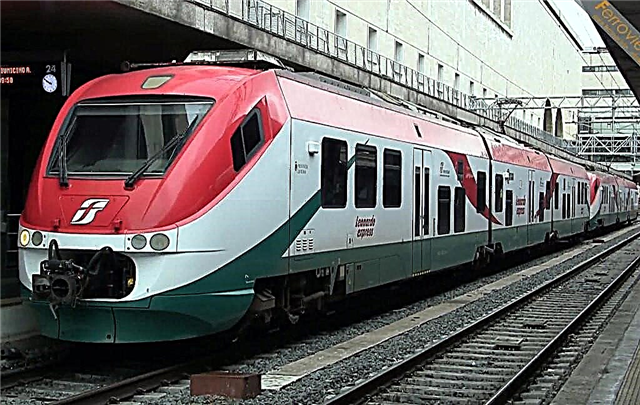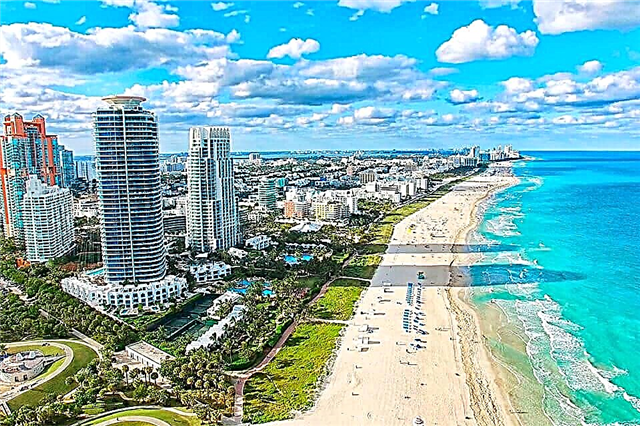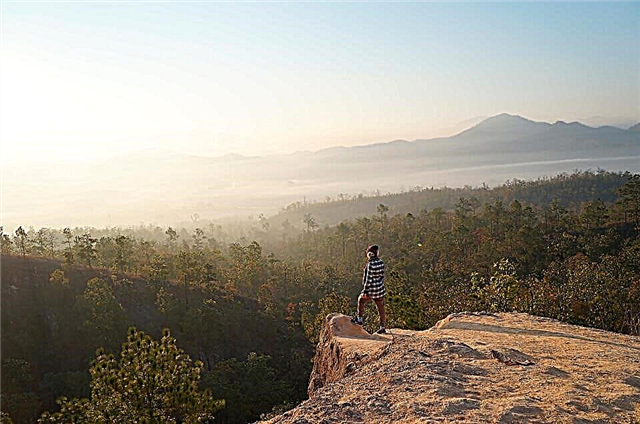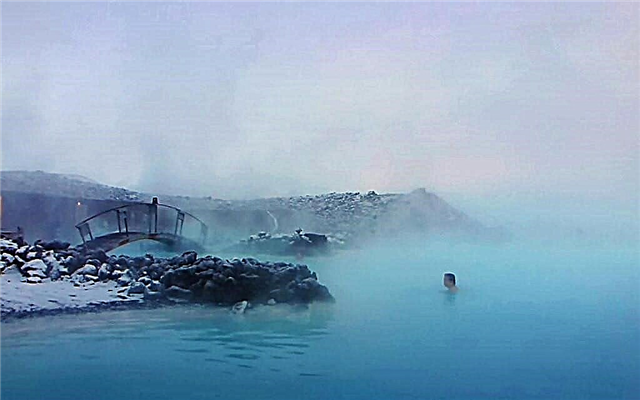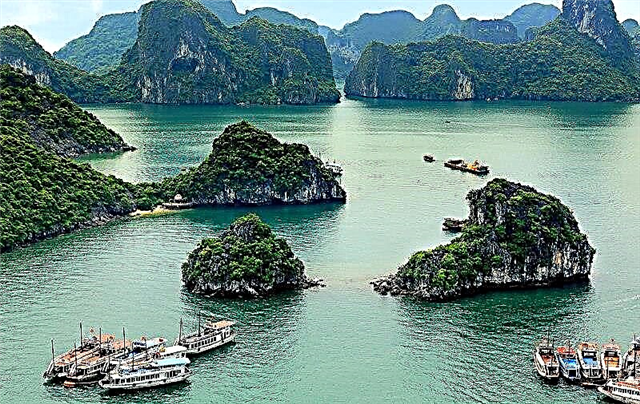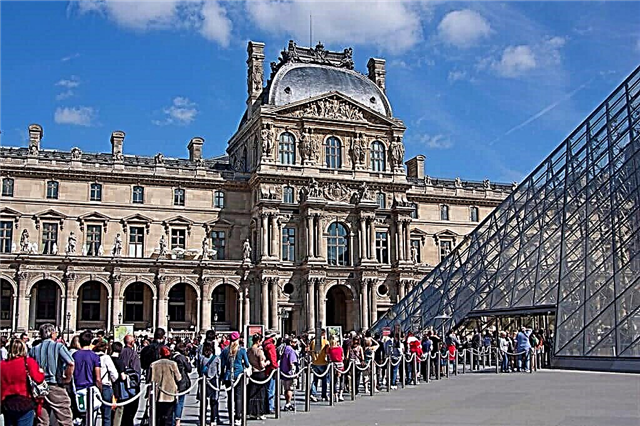France is one of the most visited countries in the world by tourists, with a developed infrastructure and excellent recreational opportunities. The main attractions are natural beauty, gastronomic delights, architectural monuments and museum collections, containing a huge number of world masterpieces.
Paris is the most romantic city in the world. Its beauty will always stand apart; tourists try to visit the capital first of all. Newlyweds dream of spending their honeymoon here, couples with children - to show the kids the wonderful world of Disneyland Paris. The second point in the travel program is the palaces and castles scattered throughout the country or the natural beauty of Provence and Normandy.

Popular hotels at affordable prices.
from 500 rubles / day
What to see and where to go in France?
The most interesting and beautiful places for walking. Photos and a short description.
Eiffel Tower
The main symbol of Paris and all of France. Named by the name of the creator. It was erected in 1899 to be used as an entrance arch to the World's Fair. Subsequently, the construction was planned to be disassembled, but the attraction stuck. The main material is steel, the height is 324 meters. Anyone can visit the tower. In the evenings, the backlight comes on, colors can change for significant events.

Triumphal Arch
Napoleon personally gave the order for its construction: this is how the emperor was going to perpetuate the victories of his "Great Army". The arch was completed in 1836. Currently, the square where it is installed bears the name of Charles de Gaulle. The height of the monument is 50 meters. The design is replete with small details. Under the vaults after the First World War, the tomb of the unknown soldier and the eternal flame appeared.

Orsay Museum
In the past, the museum building served as a Paris station. First, the station was closed, and the premises were mothballed, later it was reconstructed. One of the world's most impressive collections of fine art became available for inspection in 1986. The exhibits are divided into levels and halls based on style and chronology. The collections are dominated by Impressionist and Post-Impressionist paintings.

Louvre Museum
The most popular museum in the world, opened its doors to visitors in 1793. Its glass pyramid is one of the symbols of the French capital. The number of visitors in 2018 exceeded 10 million, which was a record. The Louvre collection - paintings, decorations, sculptures and figurines, frescoes and furniture. The number of masterpieces in the collection is innumerable, one of the main exhibits is "Mona Lisa" by Leonardo da Vinci.

Champs Elysees
Chanz Elise is the central street of Paris, one of the most beautiful, green and famous in the city. It stretches along the central part of the French capital for almost 2 km. The Champs Elysees are traditionally divided into two parts: a shop, with boutiques, offices, banks and a park. The walking park is divided by alleys into squares, each of which has its own "specialization". For example, in Marigny there is a market for philatelists and a theater, and in the Elysee square is the residence of the president.

Cote d'Azur
Another name is the French Riviera, a stretch of the Mediterranean coastline from the city of Toulon to the border with Italy. One of the best vacation spots in the world. Local cuisine is a feast for gourmets. On the Cote d'Azur special dishes and wines are served, some are found only here. The disadvantages include high prices for vacations and real estate.

Disneyland Paris
An amusement park in the Parisian suburb of Marne-la-Valais, has been operating since 1992. The park is owned by the American company Walt Disney. This is a magical world for children, where all the famous characters of "Disney" cartoons live, scenery from favorite fairy tales has been recreated, and countless attractions also work, delighting adults. The park is home to residential and business districts, hotels and golf courses.

Exchange Square (Bordeaux)
The symbol of the city of Bordeaux and its main attraction. The architectural ensemble consists of two long Baroque buildings and adjacent buildings. Among them are the Chamber of Commerce and the Customs Museum. The pediments are decorated with sculptures. The square was created in the first half of the 18th century according to the project of Ange-Jacques Gabriel - the royal architect, the founder of classicism.

Sainte-Chapelle (Paris)
The chapel was built on the Ile de la Cité in Paris. Although the building belongs to the Gothic style, it is "airy" and "light". It's all about the stained-glass windows, shimmering in the sun and towering almost the entire height of the walls. They feature numerous symbols. To understand them, you need to use the TV screen installed in Sainte-Chapelle. Painted columns support the vaults of the upper chapel.

Notre dame cathedral
The Gothic Catholic Church, sung in the work of Hugo, is another symbol of Paris and France. Its construction took centuries. The first stone was laid by Pope Alexander III in 1163. In 2019, during the reconstruction, there was a strong fire in the building. The fire destroyed some rarities and unique furnishings. The restoration will cost about a billion euros and will take years.

Basilica of the Sacre-Coeur (Paris)
The name is translated as "Basilica of the Sacred Heart". Construction period: from 1875 to 1914. The white-stone church is somewhat different from other Catholic sites in Paris, at one time its appearance caused discontent among the townspeople. Located at the top of Montmartre, the highest point in the city. The Sacre-Coeur bell tower has the Savoyard, the largest bell in the French capital.

Basilica of Notre Dame de la Garde (Marseille)
The main historical landmark of Marseille. Built in the middle of the 19th century on the site of an old chapel. The place is significant: for centuries pilgrims were received here and travelers were blessed. The lead architect of the project is Henri-Jacques Esperandieu. The bell tower is crowned with a 9-meter sculpture of the Mother of God. The bell weighs over 8 tons. Frescoes and mosaics are a typical decoration for interiors of that time.

Basilica of Notre Dame de Fourvière (Lyon)
It was erected from 1872 to 1884 on the top of the Fourvière hill. The lands around Lyon have repeatedly faced adversity: from plague to enemy armies under the walls of the city. Each time the inhabitants prayed to the Virgin Mary, and the Mother of God, in their opinion, averted trouble. They worked on the construction for more than 10 years, and the interior decoration was completed only in 1964. The basilica is richly decorated with stained glass windows, murals, mosaics and statues.

Abbey of Mont Saint-Michel
The translation of the name is “Mount St. Michael”. The building is dated by the XI century. This fortified abbey sits on the island of the same name. In the central part, the castle itself rises, and along its perimeter there are dense buildings, wild bushes and trees. The walls are solid and more like a fort. Depending on the season, the area around may be completely covered with water. Sometimes it even floods the road leading to Mont Saint Michel.

Palace of Versailles
Royal residence, built on the outskirts of the French capital in the second half of the 17th century. This landmark was among the first to be included in the UNESCO World Heritage List. The halls of the palace are kept in exemplary condition. The furnishings and furnishings correspond to the past. No less than the castle, tourists are interested in an extensive park complex. About 1400 fountains function on its territory.

Laura's castle
The entire Loire Valley is included in the UNESCO World Heritage List. While traveling here, tourists are introduced to a number of cities, including Orleans, Nantes and Angers.In them and their surroundings, majestic castles have been erected, created for the royalty and noble people of France, who wanted to escape from the bustling Paris. So the castles of Chambord, Cheverny, Chateau de Chenonceau are built against the backdrop of endless meadows and forests.

Fontainebleau palace
Located 60 km from Paris in the Seine-et-Marne department, surrounded by a huge park. Since 1981 it has been under the protection of UNESCO. The history of the palace began in the XII century, but only 5 centuries later, it acquired its current sophisticated and majestic features. In the architecture, you can see elements of the medieval style, the classics and the Renaissance. Four French monarchs were born in the palace.

Old town Carcassonne
Among the historical sights, the medieval walled city has been the second most visited city in France for many years. The walls of impressive thickness surround not only the castle, but also numerous buildings inside the fortress itself. Behind the towers are narrow streets and small houses, which are still used for their intended purpose.

Papal Palace in Avignon
Another French site included in the UNESCO World Heritage List. Consists of a complex of two palaces. The first - aka Old - was erected by order of Benedict XII and is more ascetic. The second - New - was built in the Gothic style for Clement VI and has extravagant features. The powerful outer walls had to withstand the siege. They have loopholes and airlocks for attacking attackers.

Amphitheater in Nimes
It is not as advertised as the Colosseum, but it is not much inferior to it in terms of historical significance. Built by the Romans in the 1st century. Even then, the sewerage system and water supply were brought to it. Used for gladiatorial battles. Subsequently, it became a fortress, which also affected the appearance of the structure. The original view of the amphitheater was returned only in the 18th century. Nowadays, live concerts are held in the arena.

Aqueduct Pont du Gard
The tallest surviving ancient aqueduct. It was built by the Romans, about 2 thousand years ago. The three-tiered arched structure crosses the Gardon River. The height is 49 meters and the length is 275 meters. The bridge was used as an integral part of the aqueduct and helped provide water to nearby Nîmes. When the need for it disappeared, the aqueduct was abandoned.

Viaduct Millau
One of the tallest bridges in the world. One of its pillars reaches 341 meters, which is higher than the Eiffel Tower. Millau is built across the Tarn Valley near the city of the same name. The viaduct is part of the A75 motorway linking Paris with the city of Béziers. The authors of the project are architect Norman Foster and engineer Michel Virlogeau. Despite the massive columns, their creation looks light, and with low clouds, as if floating in the air.

"Petite France" (Strasbourg)
A romantic and picturesque quarter of Strasbourg, inscribed on the UNESCO World Heritage List. In the distant 16th century, fishermen and artisans engaged in leather dressing settled here, which is why an unpleasant smell took root in the streets. Now "Petite France" has become an exquisite historic district with half-timbered houses, balconies buried in flowers, quiet alleys and covered bridges across the Ile River.

Colmar city
Colmar is the most beautiful city in Alsace. The old areas are well preserved. At the first visit, it seems that he was in the scenery of a filming fairy tale. Little Venice and the Fisherman's Quarter are the most interesting parts of the city. Colmar's microclimate contributes to the development of winemaking. 5 museums are open, including the Unterlinden Museum. There is a major festival almost every month of the year.

Claude Monet's garden at Giverny
The famous artist lived in this place for 43 years. Monet's house, converted into a museum, stands in the middle of the garden. The interiors have been kept original, and personal belongings of the master have been added to them. The room is bright both inside and out. The same can be said about the garden. It looks like a lot of colors are moving chaotically. Arches of plants, partially overgrown paths, many flowers welcome guests in Giverny most of the year.

Park "Tet d'Or" (Lyon)
It covers 117 hectares and is located in Lyon. The territory began to be improved in the middle of the nineteenth century. It now has stables, a velodrome, a zoo, a golf course and a nearby train. Tourists ride on rented boats on the lake. One of the islands can be reached through a tunnel dug under the reservoir. The botanical garden at Tet d'Or consists of an impressive collection of plants.

Dune in Pyla
The highest dune in Europe is increasing in size from year to year. At the moment, its height is over 130 meters. The sandy anomaly is located on the shores of the Arcashon Bay. A tourist infrastructure has been created around the mountain to make the climbs safer and more comfortable. Parking, souvenir shops, cafes serving fresh oysters, small hotels - everything is within walking distance.

Lasko cave
Discovered in the commune of Montignac on the banks of the Weser River in 1940. The cave has become a real discovery in the field of archeology. She is a key element in the study of the Paleolithic era. The quantity and quality of rock carvings surpasses all other sources. Lascaux is called the "Sistine Chapel of Primitive Painting". At the same time, the dimensions of the cave are relatively small: up to 30 meters in height and about 250 meters in length.

Mont Blanc
The highest mountain range in Europe (excluding Elbrus). Located on the border of France and Italy, under Mont Blanc there is a tunnel between the countries. There are many ski slopes of any difficulty. There are also "wild" slopes that attract extreme lovers. The conditions for mountaineering and hiking are well developed. A popular tourist route “Tour du Mont Blanc” is laid around the mountain.

Lake Annecy
One of the most beautiful alpine lakes. Located in North Savoy. In size in France, it is second only to Lake Lac du Bourget. The area is popular with tourists. Boat trips, water bike rentals, water activities are available, attractions are installed on the beaches. From the south, a valley approaches the lake, from the other sides it is surrounded by mountain ranges.

Corsica
An autonomous French territory occupying the island of the same name in the Mediterranean. Representatives of many peoples lived in these territories at different times, so a special language dialect appeared here. Natural beauty is the main treasure of the area. Bays and beaches, forests and mountains - all along and across are explored by tourists, but they look as if they were untouched by man. The most famous Corsican is Napoleon Bonaparte.

Verdon gorge
One of the main tourist sites in Provence. At the same time, the longest and deepest gorge in France. Located in the Alps, in the southeastern part of the country. The natural landmark is called the "French Grand Canyon". In the vicinity there are hiking trails for hikers, horse rides are organized, kayaks are rented for rafting.

Calanques
Small picturesque bays, French "fjords", which are located on the coast from Marseille to Lea Ciot and Cassis. The national park was founded in 2012 and became the first protected area in Europe, which includes the periphery of cities, part of the sea and land. Small bays and islets have created a unique ecosystem. Therefore, many rare species of flora and fauna live here. Rock climbers have chosen the Kalanki Mountains for training.

Etretat cliffs
The name "Etretat" is translated as "farm of the setting sun." Such a poetic name, coupled with the unusual appearance of the rocks, has attracted travelers at all times. Noble people rested here, and artists and writers drew inspiration. The cliffs rise tens of meters, they are snow-white and have bizarre shapes, there are many natural arches.

Lavender fields of Provence
The main brand and business card of the region are endless purple rows of fragrant lavender stretching beyond the horizon.A favorite destination for artists and photographers, the number of tourist postcards rivals the Eiffel Tower. The Valensole plateau is especially densely and densely planted. The best time to travel is the end of June, when the annual Lavender Festival begins.


